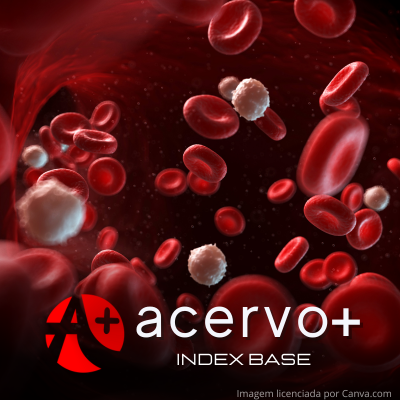Doença hemolítica do recém-nascido
##plugins.themes.bootstrap3.article.main##
Resumo
Objetivo: Analisar a Doença hemolítica do recém-nascido (DHRN) e suas repercussões na saúde materno-infantil. Revisão bibliográfica: A DHRN é uma condição na qual a gestante, já sensibilizada com aloantígenos, produz anticorpos contra as hemácias do feto, ocorrendo nos casos de incompatibilidade pelo sistema ABO ou Rh em sua maioria. Os anticorpos produzidos pela mãe são majoritariamente do tipo anti-D, sendo que apenas a classe IgG atravessa a barreira hematoplacentária e causa a doença. Para diagnóstico, deve ser feito estudo da tipagem sanguínea materna e paterna, ultrassom obstétrico e dopplervelocimetria fetal. Quando a doença é de caráter leve-moderado, não há grandes repercussões e a terapêutica pode ser realizada com um bom prognóstico; entretanto quando um estado grave se instala, com desenvolvimento de Kernicterus e hidropisia, o tratamento se torna mais complexo e custoso. Considerações finais: Por se tratar de uma doença evitável na maioria dos casos por meio da profilaxia pela imunoglobulina anti-D é recomendado sua utilização de forma adequada a fim de reduzir o aparecimento da doença e suas complicações.
##plugins.themes.bootstrap3.article.details##
Copyright © | Todos os direitos reservados.
A revista detém os direitos autorais exclusivos de publicação deste artigo nos termos da lei 9610/98.
Reprodução parcial
É livre o uso de partes do texto, figuras e questionário do artigo, sendo obrigatória a citação dos autores e revista.
Reprodução total
É expressamente proibida, devendo ser autorizada pela revista.
Referências
2. AYENEW AA. Prevalence of rhesus D-negative blood type and the challenges of rhesus D immunoprophylaxis among obstetric population in Ethiopia: a systematic review and meta-analysis. Maternal Health, Neonatology and Perinatology, 2021; 7(8): 1-11.
3. BHUTANI VK, et al. Neonatal hyperbilirubinemia and Rhesus disease of the newborn: incidence and impairment estimates for 2010 at regional and global levels. Pediatric Research, 2013; 74 (1): 86-100.
4. CAO H, et al. Oral administration of Chinese herbal medicine during gestation period for preventing hemolytic disease of the newborn due to ABO incompatibility: A systematic review of randomized controlled trials. Plos One, 2017; 12(7): 1-23.
5. CLAUSEN FB. Lessons learned from the implementation of non-invasive fetal RHD screening. Expert Review of Molecular Diagnostics, 2018; 18(5): 423-431.
6. DE WINTER DP, et al. Hemolytic disease of the fetus and newborn: systematic literature review of the antenatal landscape. BMC Pregnancy and Childbirth, 2023; 23(12): 1-10.
7. DING Z, et al. Application of IgG antibody titer and subtype in diagnosis and severity assessment of hemolytic disease of the newborn. Translational Pediatrics, 2022; 11(9): 1544–1551.
8. DZIEGIEL MH, et al. Laboratory Monitoring of Mother, Fetus, and Newborn in Hemolytic Disease of Fetus and Newborn. Transfusion Medicine and Hemotherapy, 2021; 48(5): 306–315.
9. FERNANDES Â, et al. A eritroblastose fetal em sua amplitude (Enfermagem). Repositório Institucional, 2023; 1(1): 1-16.
10. FERNANDES AP, et al. Prevalência de isoimunização Rh materna em maternidade pública do Amazonas entre 2018 e 2020. Revista Eletrônica Acervo Saúde, 2021; 13(9): 1-8.
11. HARTWELL EA. Use of Rh immune globulin: ASCP practice parameter. American Society of Clinical Pathologists. American Journal of Clinical Pathology, 1998; 110(3): 281-292.
12. HENDRICKSON JE e DELANEY M. Hemolytic Disease of the Fetus and Newborn: Modern Practice and Future Investigations. Transfusion Medicine Reviews, 2016; 30(4): 159–164.
13. KAKKAR B, et al. Exchange transfusion in neonatal hyperbilirubinemia: A single Centre experience from Northern India. Transfusion and Apheresis Science, 2019; 58(6): 102655.
14. MOISE KJ. Fetal anemia due to non-Rhesus-D red-cell alloimmunization. Seminars in Fetal and Neonatal Medicine, 2008; 13(4): 207-214.
15. MYLE AK e AL-KHATTABI GH. Hemolytic Disease of the Newborn: A Review of Current Trends and Prospects. Pediatric Health, Medicine and Therapeutics, 2021; 12(1): 491–498.
16. NARDOZZA LMM. Doença hemolítica perinatal. Femina, 2020; 48(6): 369–374.
17. PAN W, et al. Fetal and neonatal outcome in severe alloimmunization managed with intrauterine transfusion: 18-year experience in a tertiary referral hospital in China. Fr in Pediatrics, 2023; 11(1): 1-7.
18. PINHEIRO AMR, et al. Doença hemolítica do recém-nascido e suas consequências. Hematology, Transfusion and Cell Therapy, 2022; 44(S2): 622–623.
19. RENNIE JM, et al. Learning from claims: hyperbilirubinaemia and kernicterus. Archives of Disease in Childhood. Fetal and Neonatal Edition, 2019; 104(2): 202-204.
20. RUNKEL B, et al. Targeted antenatal anti-D prophylaxis for RhD-negative pregnant women: a systematic review. BMC pregnancy and childbirth, 2022; 20(83): 1-10.
21. SCHMIDT LC, et al. Genotipagem RhD fetal não invasiva no acompanhamento de gestantes RhD negativo. Femina, 2011; 39(7): 337–344.
22. SCHMIDT LC, et al. Atualizações na profilaxia da isoimunização Rh. Femina, 2010; 38(7): 347-352.
23. VAN ’T OEVER RM, et al. Identification and management of fetal anemia due to hemolytic disease. Expert Review of Hematology, 2022; 15(11): 987–998.
24. WEBB J e DELANEY M. Red Blood Cell Alloimmunization in the Pregnant Patient. Transfusion Medicine Reviews, Transfusion Medicine in Obstetrics, 2018; 32(4): 213–219.
25. ZIPURSKY A e PAUL VK. The global burden of Rh disease. Archives of Disease in Childhood. Fetal and Neonatal Edition, 2011; 96(2): 84-85.
26. ZWIERS C, et al. Immunoglobulin for alloimmune hemolytic disease in neonates. The Cochrane Database of Systematic Reviews, 2018; 3(3): 1-64.

